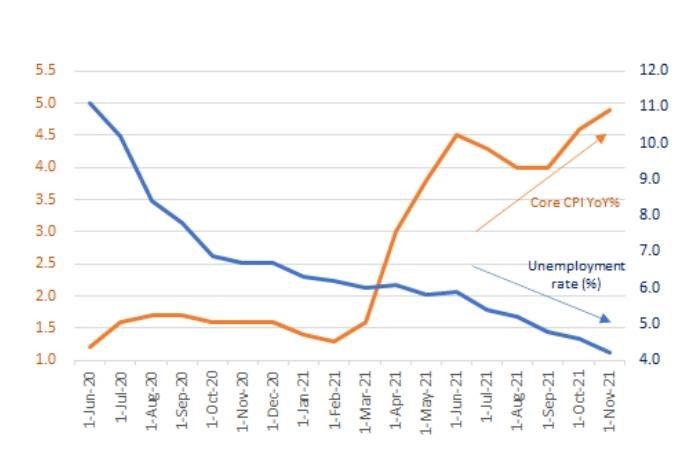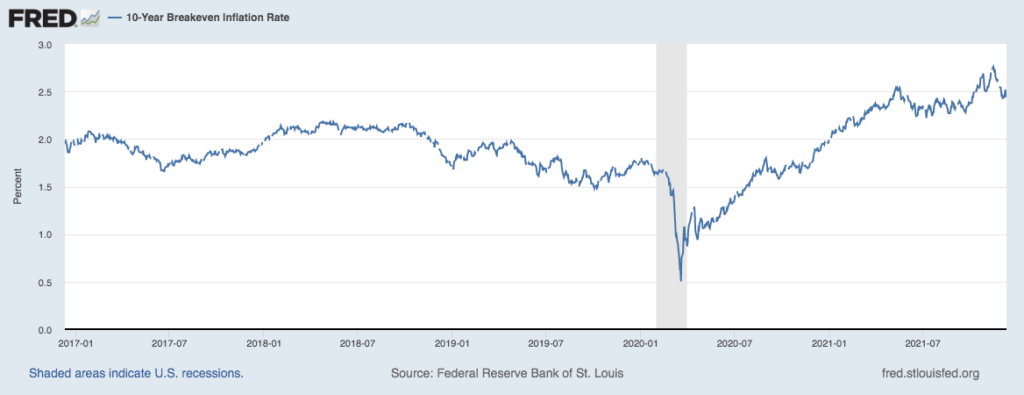by William Henderson, Vice President / Head of Investments
Last week the markets shrugged off Omicron-related news and strong November inflation numbers as all three major indexes closed higher. The Dow Jones Industrial Average jumped by +4.0%, the S&P 500 Index rose by +3.8%, setting a record, and the NASDAQ gained +3.6%. With fewer and fewer days left in the year, we are moving to close 2021 out with some near record levels on all three major indexes, giving us quite a year of overall returns. Year-to-date, the Dow Jones Industrial Average has returned +19.7%, the S&P 500 Index +27.2% and the NASDAQ +22.0%. As mentioned, the year-over-year CPI (Consumer Prices Index) for November was reported at +6.8%, the highest reading on inflation since 1982. This information gives Fed Chairman Jay Powell the ammunition needed to consider moving interest rates higher before June 2022, which was the previously telegraphed date. We will get some further direction this week at the FOMC (Federal Open Market Committee) meeting December 14-15. The 10-year U.S Treasury ended the week at 1.47%, seven basis points higher than last week and still below 1.74% level reached in March of this year.
Chairman Powell will consider the Fed’s so-called “dual mandate,” 1) average inflation at 2% and 2) unemployment rate at 4.1%. See the chart below from Factset which shows we are nearing the point where both mandates are being met.

It is likely that the FOMC announces a faster pace in their balance sheet tapering process. Currently, they are tapering (reducing purchases of bonds) by $15 billion per month; an increase to $30 billion per month is likely. At that rate, the Fed would wind down the tapering process by March of 2022, thereby allowing the start of the rate hikes, if needed. At any rate, we expect rate hikes to be clearly telegraphed, measured and incremental.
A lot of noise is being made about rates hikes and the Fed “Hawkish Pivot,” meaning a Fed that will raise rates rather than keep them lower. Certainly, interest rates at the Fed’s current target range of 0.00 – 0.25%, are accommodative to economic growth, but interest rates at 100 or even 200 basis points higher are still considered accommodative by historical standards. We are not predicting huge interest rate moves like that, but it seems to us that higher rates are inevitable. When we look at the Fed’s last tightening cycle (December 2015 – June 2019), interest rates moved from 0.00% (post the Great Recession) to 2.50%. During the period, the S&P 500 Index moved higher by 57% (or 11% per year). Of course, past performance is never a preview of future performance, but we showed that data simply to prove that markets can move higher even while the Fed removes monetary accommodation.
Lastly, even while the Fed begins to raise interest rates, we expect bonds to continue to offer investors an important risk management tool – critical to their portfolios. A look at the current U.S. Treasury 10-Year Breakeven Inflation Rate shows the level at 2.44% (Federal Reserve Bank of St. Louis). The breakeven inflation rate represents a measure of expected inflation derived from 10-Year Treasury Constant Maturity Securities and 10-Year Treasury Inflation-Indexed Constant Maturity Securities. The latest value (2.44%) implies what market participants expect inflation to be in the next 10 years, on average, well below the 6.8% inflation number released last week.

Watch for retail sales data this week as we get our first glimpse of holiday shopping data. Further, early indications show supply chain issues are slowly getting worked out in West Coast ports as we showed last week with falling shipping rates (China to U.S.). The Omicron variant’s impact seems to have abated a bit in the U.S. while the opposite is happening in the U.K and elsewhere globally. The Fed and the Biden Administration have their hands full and will need to decide where, when and how to remove monetary and fiscal stimulus, both of which have powerfully and effectively fueled strong price inflation in goods and services. Wall Street trading desks will be thinly staffed for the next few weeks; so, watch for limited volatility but remain focused on your long-term goals.
